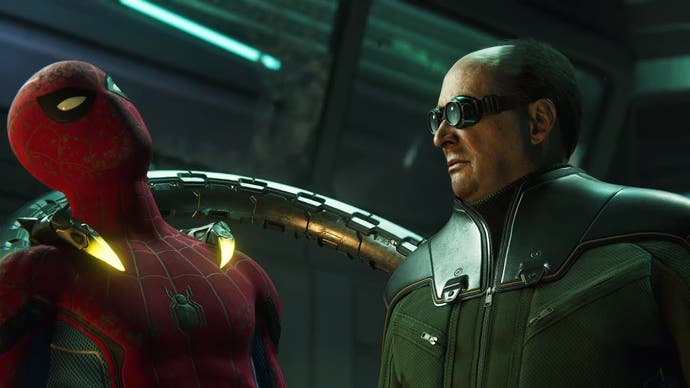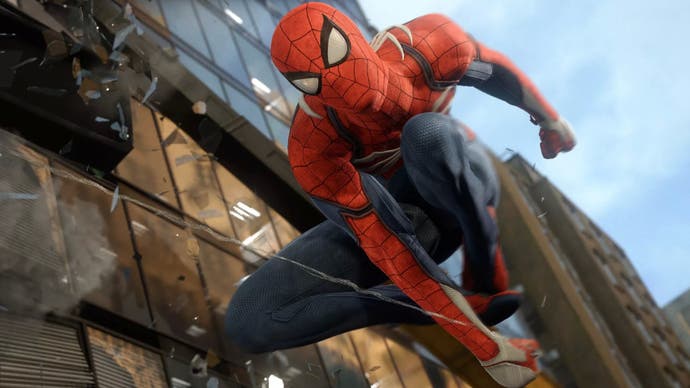Marvel's Spider-Man has thought a lot about accessibility
With great power...
Spoiler Alert: This piece discusses the ending of Marvel's Spider-Man.
"Welcome to "Just the Facts," with J. Jonah Jameson. Spider-Man is the best superhero game ever made! Wait! Who's writing this rubbish? Vivek Gohil? Well, I want you to fire him."
Seriously, though, Insomniac Games' respect for Spider-Man's history shines through in every aspect of the webslinger's latest, from the story and world-building to the combat, gadgets and traversal mechanics. The Spider-Man mythos has been remixed beautifully. Look at how the game's story flips the relationship between Spider-man and Otto Octavius. The traditional antagonistic relationship has been transformed into the tragic story of a student forced to revolt against his well-meaning mentor. It was a gut-punch watching the slow destruction of a brilliant mind into a twisted but believable villain.
There's something else too. As a disabled gamer, the new trend of triple-A games including accessibility options is extremely important. Gaming should be completely inclusive. Imagine playing Halo Infinite without a fancy gun or Super Mario World without a jump button. Well, that's how it sometimes feels to be a gamer with a disability.
Spider-Man has accessibility options. You can change button taps to holds, you can auto-complete QTEs and skip puzzles, which are all brilliant inclusivity measures. The game has many QTEs which can be stressful due to their unpredictability, for example, and auto-completion removes that unnecessary anxiety completely. I remember playing the Tomb Raider reboot back in 2013 and struggling through the incessant QTEs.
 6 Things We Loved About Marvel's Spider-Man (And 1 Thing We Didn't) Marvel's Spider-Man PS4 Gameplay
6 Things We Loved About Marvel's Spider-Man (And 1 Thing We Didn't) Marvel's Spider-Man PS4 Gameplay
Nevertheless, there are still some elements of Spider-Man's design that clash with accessibility. The combat is already fast-paced, requiring multiple button presses for jumping, punching, gadgets, dodging, webbing, throwing objects and activating suit powers, so why did they include a button press for healing? When playing the game, I can't press the heal button, so Gang Hideout combat challenges in particular can become much more difficult and frustrating. Regenerating health would have made gameplay a lot more accessible for many disabled people. In the comics Spider-Man does have the ability to regenerate, so this would have narrative validity too.
The biggest difficulty with the controls of Spider-Man - and it was also present in God of War - is the need to press both R3+L3 to activate suit powers. This affects the final boss fight in particular since suit powers are necessary to refill gadgets. For many disabled gamers this input is impossible, so they would require assistance.
I've been thinking about a solution to this conundrum of R3+L3 input quite a bit, so here's my potential solution for Spider-Man controls. Alongside adding regenerating health, Insomniac could change D-pad down for dive/perch, up for the radar ping, left for the camera and right to activate suit powers.
Beyond the controls, Spider-Man bucks the trend of portraying disability and specifically wheelchair-users in a negative light by creating various wheelchair-user NPCs going about their days, reading the newspaper or filling in a crossword. The world in Spider-Man does not try to erase disability completely, but rather seeks includes it in a small but fresh way. Other games still find this surprisingly difficult. For example, Lester Crest from GTA 5 offers a positive view of disability, but he also appears to be the only wheelchair-user present in the whole world of Los Santos.

Spider-Man has its problems though. I thought the final cutscene with Doctor Octopus was perfect from a narrative perspective: I understood both Peter's grief and Otto's desperation. But the scene was also quite shocking as someone living with a neuromuscular condition (Duchenne Muscular Dystrophy). If we analyse Otto's character evolution from the compassionate Otto Octavius into the ruthless Doctor Octopus, we can discover these negative disability stereotypes.
Firstly, there's the supercrip stereotype, Otto obsesses over 'fixing' his neuromuscular condition by creating four psychically controlled tentacles that exceed the limitations of his failing body by making him superhuman.
There's the victim stereotype, as Otto cannot bear the horror of being "trapped in a useless body" so begs Peter not to remove his neural interface.
Finally, there's the villain stereotype, as Otto will commit any act regardless of morality or compassion - evidenced by the outbreak of Devil's Breath - just to gain revenge on Osborn.
Those points highlight that even a game with accessibility options still can be held back by negative disability stereotypes used in storytelling. Positive disability representation is a rare commodity. In games such as Batman: Arkham Knight, Bloodborne and Dead Space a 'wheelchair' represents helplessness, weakness and signifies the horror of getting 'trapped' forever.
Hopefully this can change, just as the gaming industry has woken up to the idea that accessibility and inclusion is important so that a minority of gamers are not excluded from the beauty of video games. Just three years ago Destiny was praised for adding a colour-blind option. And even after the release of God of War this year, Santa Monica Studios listened to feedback and added an alternate option to activate rage mode by pressing triangle + circle. It's important to stress, though, that this is only the beginning of the accessibility movement, and progress is still necessary. Games, after all, are for everybody, and the great power that designers wield comes with great responsibility.









